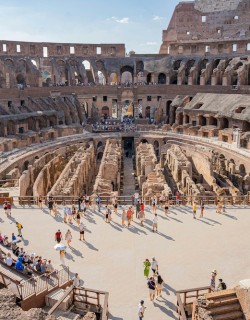Walking group tours and Italians alike pass this chunk of Ancient Roman history everyday, often stopping to take photographs or marvel at its somewhat mythical look. Pons Aemilius, or “Ponte Rotto” (Broken Bridge) as it is often referred to, is known to be the oldest stone bridge in Roman history, originally providing access across the Tiber River, connecting Trastevere and the Forum Boarium, a cattle market in its day.
The bridge in its original form was made of wood, as all bridges were at the time. However, in 179 BC, it was reconstructed of wood and stone by Marcus Fulvius Nobilior, a Roman Censor and General, marking an important moment in Roman engineering. As innovative as the Romans were, they also built things to last, so the Pons Aemilius wasn’t actually fully completed until 151 BC, once the Romans mastered their method of excavation into the Tiber riverbed. After its arches were added in 142 BC by Publius Scipio Africanus, the bridge underwent semi-regular repairs due to its precarious location on the Tiber River, just below the Tiber rapids and immediately above a sharp turn, leaving it susceptible to intense floods, torrents, and general wear and tear.
In the second century BC, Augustus, followed by Emperor Probus, made significant improvements and repairs to the bridge as Roman engineering advanced. These improvements created 5 spectacular arches made from ashlar blocks which were supported by 4 stone support piers, thus making Pons Aemilius Rome’s first stone arch bridge and the first made entirely of stone. Keep in mind, bridge arches needed to be extremely reliable, stronger than aqueducts or triumphal arches, as they needed to be able to withstand the weight and pressure of the traffic passing across. The gradual transformation of Pons Aemilius into an all-stone bridge was indeed ahead of its time, and a monumental moment in the history of Ancient Roman engineering.
After the collapse of the Roman Empire, the bridge was inevitably neglected and suffered significant damages on several occasions due to invasions, floods and torrents, each one worse than the last. In 1598, a massive flood (the worst in Rome’s history) destroyed about half of the bridge, carrying away 3 arches and 2 piers. For several years, the remaining section of the bridge was used as a fishing pier for local fishermen.
In 1887 Italian architect Angelo Vescovali had an arch and 2 piers demolished to make space for Ponte Palatino. What was left, still standing to this day, is the central arch of the bridge, unreachable from either side; the lone remnant and reminder of this once great structure and product of revolutionary Ancient Roman engineering and architecture. Although it is inaccessible, the remaining arch acts as bridge for the mind, covered in foliage, still standing strong as a living legend of the Roman Empire.
~by Michele D’Elia~



